Abstract
Recent interest in the application of mid-infrared (mid-IR) lasers has made the generation of ~3 µm ultrafast pulses a hot topic. Recently, the generation of femtosecond-scale pulses in Er3+-doped fluoride fiber lasers has been realized by nonlinear polarization rotation (NPR). However, a numerical study on these fiber lasers has not been reported yet. In this work, the output properties of the NPR passively mode-locked Er3+-doped fluoride fiber ring laser in ~3 µm have been numerically investigated based on the coupled Ginzburg–Landu equation. The simulation results indicate that stable uniform solitons (0.75 nJ) with the pulse duration of femtosecond-scale can be generated from this fiber laser. This numerical investigation can provide some reference for developing the high energy femtosecond soliton fiber lasers in the mid-IR.
1. Introduction
Due to the potential applications in the defense, laser microsurgery, mid-infrared spectroscopy, and the pump source for longer wavelength mid-infrared or far-infrared oscillators, ultrafast pulse lasers operating in ~3 µm mid-IR wavelength band have been focused on more and more by researchers [1,2,3]. To date, Er3+-doped fluoride fiber has been considered as a perfect gain media for ~3 µm mode-locked fiber lasers due to its broad emission wavelength band (2.71 to 2.88 µm). Moreover, its nonlinear coefficient in ~3 µm is far below those of other silica fibers (whose pulse energy is limited to ~0.1 nJ by the soliton area thorem [4]) in near-IR, which is beneficial to the production of higher energy soliton pulses from ultrafast fiber lasers [5].
Generally, ultrafast pulses can be achieved by passive mode-locking techniques. These techniques generally can be classified to two types. The first one is material saturable absorber (SA)-based mode-locking such as semiconductor saturable absorber mirrors (SESAMs) [6,7,8], graphene [9], and some graphene-like 2D nonlinear materials [10,11,12,13,14,15,16]. Nevertheless, numerous 2D material SAs are limited by the inherent deficiencies such as relatively low damage threshold and short life-time; they are hardly a guarantee of long-term operation especially when the mode-locked lasers are operated at high pulse energy. In addition, the reported pulse durations for the 2D material SAs-based mode-locking in Er3+-doped fluoride fiber laser were limited to be picosecond scale due to the low modulation depth of the material SAs in mid-IR [9,14,15]. The second one is optical Kerr-effect based mode-locking, for example, nonlinear polarization rotation (NPR) technology [17,18,19]. As an artificial saturable absorber, NPR technology shows the advantages of fast response time, higher damage threshold, and long-term stability at high pulse energy operation, which has been considered to be one of the most attractive approaches to achieve the stable high energy ultrafast pulse laser. Previously, researchers have realized the generation of femtosecond-scale pulses in Er3+-doped fluoride fiber lasers passively mode-locked by NPR [20,21,22]. However, a numerical study on these fiber lasers has not been reported yet.
In this paper, we report on the numerical investigation of a NPR passively mode-locked Er3+-doped fluoride fiber ring laser at ~3 µm. The simulation results indicate that this fiber laser enables the generation of stable uniform solitons up to 0.75 nJ with the pulse duration of ~500 fs.
2. Numerical Model
The schematic diagram of the NPR passively mode-locked Er3+-doped fluoride fiber laser based on NPR is shown in Figure 1, which is the same cavity configuration as is involved in [20,21]. The ring cavity consists of an Er3+-doped fluoride fiber, a quarter-waveplate (QWP), a half-waveplate (HWP), a polarization-dependent isolator (PD-ISO), a dichroic mirror (DM), and two focus lenses. In this cavity, the Er3+-doped fluoride fiber is pumped by a 976 nm laser diode. The NPR component, consisting of a quarter-waveplate, a half-waveplate, and a polarization-dependent isolator (PD-ISO), functions as an artificial SA for mode-locking. The PD-ISO also acts as a polarizer and ensures unidirectional transmission in the ring cavity.
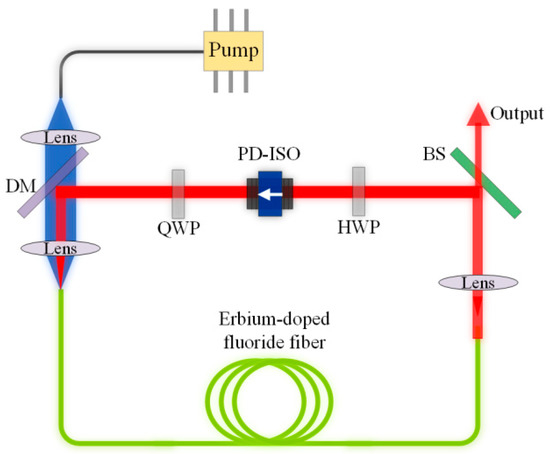
Figure 1.
Schematic diagram of the passively mode-locked Er3+-doped fluoride fiber laser. PD-ISO, polarization-dependent isolator; QWP, quarter waveplate; HWP, half waveplate; DM, dichroic mirror; BS, beam splitter.
We theoretically simulated the laser operation by using a pulse tracing technique. The pulse propagation in the fiber was studied on the basis of the well-known coupled Ginzburg–Landu equation, which can be written as
where u and v are the slowly varying amplitude envelopes of the pulses along the two orthogonal polarized axes of the optical fiber, z is the propagation coordinate, T is the time scale to the pulse duration, Δβ = 2π/Lb is the wavenumber difference between the two modes, Lb = λ/Δn is the beat length of cavity linear birefringence, γ is the nonlinear coefficient of the fiber, and parameters β2 and β3 are the second and third order dispersion coefficients of the fiber, respectively. g is the gain coefficient which can be expressed as
where T2 = 2π/(ck2Δλg ), in which Δλg is the gain bandwidth. The saturation gain g(Epulse) can be considered as
where Epulse is the pulse energy, Esat refers to the saturation energy, and g0 represents the small signal gain coefficient, which is dependent on the properties of the gain fiber and pump power of the laser.
The transmission of the laser cavity has a significant impact on the mode-locking process. The light transmission through the laser cavity can be easily calculated by using the Jones matrix method [17]. The transmission Ti can be described as
where θ is the angle between the fast axis of the fiber and the axis of the polarizer and ϕ is the angle between the fast axis of the fiber and the axis of the analyzer. Δφ is the phase difference between the x and y polarization directions of the pulsed laser after passing through the gain fiber and the waveplates, which includes the linear polarization rotation phase bias φwp caused by the waveplates, the linear phase delay (ΔφLB), and nonlinear phase delay (ΔφNL) resulting from the fiber. The expressions of Δφ、ΔφLB and ΔφNL are as follows
where nx − ny represents the linear birefringence, Δnx and Δny are the nonlinear refractive indexes, and (|u|2 + |v|2) is the light power in the cavity. According to Equations (4)–(7), the transmission of the fiber cavity can be calculated. The relationship between the intensity transmission Ti and the total phase delay Δφ is plotted in Figure 2 for θ = 0.125π and ϕ = 0.625π. Since NPR is equivalent to an artificial saturable absorber and the relationship between ΔφNL and light power is in negative correlation, the Ti increases with the light power before saturation, so we must ensure the total phase delay located at the shadow regions so as to guarantee the laser operated in the positive feedback regime.
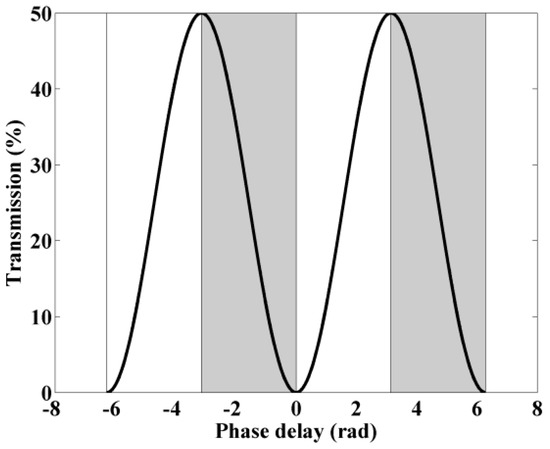
Figure 2.
Cavity transmissions with respect to the total phase delay.
In order to make the simulation possibly close to the experimental situation, the parameters listed in Table 1 were used; for simplicity the effect of loss and third order dispersion of fiber are neglected. Equation (1) can be solved numerically by the symmetrized spit-step Fourier method [23] (pp. 51–55). We started a simulation with an arbitrary weak noise signal and let it circulated in the cavity. After one round trip of propagation in the cavity the calculated results were used as the input of the next round, and the procedure repeats until a stable state of optical pulse was achieved.

Table 1.
Parameters used in the simulations.
3. Numerical Simulation Results and Discussions
Stable soliton operation can be easily obtained by properly setting the parameters. Figure 3 shows a typical soliton mode-locking for L = 5.0 m, g0 = 1.0 m−1, and Lb = 5.0 m. We can obviously observe from Figure 3a that the mode-locked pulse is formed gradually as the round trip increase. After the 50th round trip, the pulse is further shaped into an optical soliton with uniform pulse intensity from round to round. Figure 3b is the corresponding spectra of Figure 3a. Figure 3c,d shows the output pulse and spectrum profile of the NPR mode-locked Er3+-doped fluoride fiber laser in the 120th trip, respectively. From Figure 3c one can see that the pulse width and peak power are 610 fs and 1.1 kW, respectively. Obvious Kelly sidebands can be seen in the output spectrum, as depicted in Figure 3d, which means that the output pulses are typical nonlinear Schrödinger (NLS) solitons.
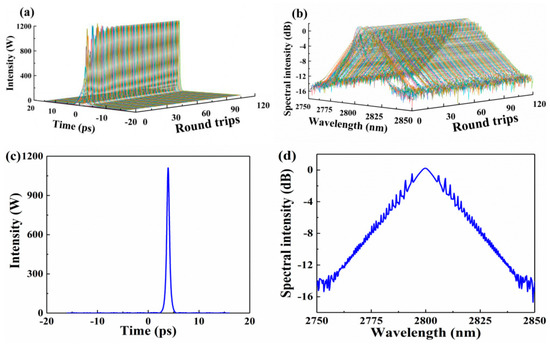
Figure 3.
Pulse (a) and spectrum (b) evolution with round trips. Output pulse profile (c) and spectrum profile (d) in the 120th round trip.
NPR mode-locking requires a long cavity to acquire enough nonlinear phase shift due to the low nonlinearity of Er3+-doped fluoride fiber. Thus, the influence of fiber length on the output characteristics of Er3+-doped fluoride fiber laser was investigated firstly. In the simulation, the small signal gain was set to 1.0 m−1. Based on the numerical simulations, it can be found that stable uniform soliton mode-locking can be achieved for the fiber length from 3.5 to 5.0 m. Figure 4 depicts the output pulse width, 3 dB spectral bandwidth, peak power, and pulse energy with respect to the fiber length when the fiber ring laser operated in the stable soliton mode-locking state. From Figure 4a, we can see the pulse width decreases from 1520 fs at the fiber length of 3.5 m to 610 fs at the fiber length of 5.0 m, which indicates that the larger nonlinear effect originating from longer fiber length is beneficial for pulse compression. Correspondingly, with the fiber length increasing from 3.5 m to 5 m, the 3 dB spectral bandwidth increases from 7.1 nm to 17.4 nm with the corresponding time bandwidth products (TBPs) of ~0.4 for this fiber length range. The slight excess indicates that the soliton pulses are small chirped. The relationships between the peak power, pulse energy, and fiber length are shown in Figure 4b. The peak power increases from 255 W to 1.1 kW with the increase of the fiber length. Correspondingly, the pulse energy increases from 0.39 nJ to 0.68 nJ, further increasing the fiber length; stable mode-locking will disappear.
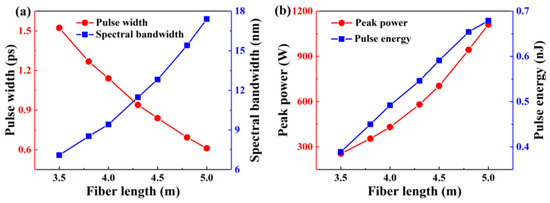
Figure 4.
Output pulse characteristics of the passively mode-locked Er3+-doped fluoride fiber laser. (a) Pulse width and 3 dB spectral bandwidth and (b) peak power and pulse energy as a function of fiber length.
The influence of the small signal gain on the output characteristics of the NPR mode-locked Er3+-doped fluoride fiber laser was also investigated. In the simulation, the fiber length was set to 5 m. According to the simulations, stable mode-locking cannot be achieved when small signal gain below 0.8 m−1. When small signal gain beyond 0.8 m−1, stable uniform soliton mode-locking can be obtained as long as the small signal gain is not exceeding 1.1 m−1. The output properties of the soliton pulses for the small signal gain varying from 0.8 to 1.1 m−1 are summarized in Figure 5. From which we can see the pulse width decreases while the peak power and pulse energy increases with the small signal gain. The narrowest pulse width of 500 fs is obtained for g0 = 1.1 m−1, with the corresponding peak power and pulse energy of 1.5 kW and 0.75 nJ, respectively. For this small signal gain range, the TBPs are calculated to be ~0.4.
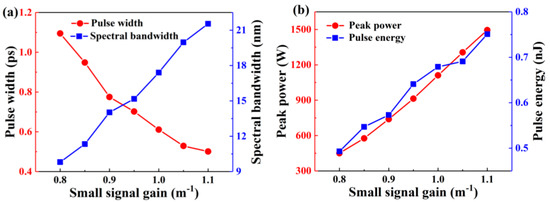
Figure 5.
Output pulse characteristics of the passively mode-locked Er3+-doped fluoride fiber laser. (a) Pulse width and 3 dB spectral bandwidth and (b) peak power and pulse energy as a function of small signal gain.
Figure 6a depicts the soliton pulses evolution with the increase of round trip for g0 = 1.15 m−1, from which we can see periodical slight intensity fluctuations appear on the output soliton pulses, namely, the output solitons are no longer uniform. Further increasing the small signal gain, these periodical intensity fluctuations on the output soliton pulses become more prominent, and the modulation period reduces as shown in Figure 6b, in which the small signal gain is set to 1.5 m−1. In this case, narrower pulse duration of ~300 fs with higher peak power of ~2.5 kW of the solitons can be achieved. The periodical intensity fluctuations can be explained by Figure 2. Even when the laser cavity is initially biased to the positive feedback regime, it will switch to the negative feedback if the soliton peak power is overlarge. In this case, the positive feedback and negative feedback will appear periodically and, hence, the soliton pulse intensity in the laser undergoes periodical variation. There are two schemes that can suppress the periodical intensity fluctuations [25]: One is controlling the pump power below the feedback switching threshold and the other is appropriately adjusting the linear polarization bias to a position where the feedback switching threshold is higher. We would like to mention that multiple solitons will be generated by further increase of the small signal gain.

Figure 6.
Pulse evolution for g0 = 1.15 m−1 (a) and 1.5 m−1 (b) with round trips.
4. Conclusions
In conclusion, we have numerically investigated the generation of soliton pulses from an Er3+-doped fluoride fiber ring laser in mid-IR near 3 µm that passively mode-locked by NPR. In the simulation, the output pulse properties of the fiber laser with various fiber lengths and small signal gains were studied. The simulation results indicate that this fiber laser enables the generation of stable uniform solitons up to 0.75 nJ (peak power of 1.5 kW) with the pulse duration of ~500 fs when the fiber length and small signal gain are set to 5 m and 1.1 m−1, respectively. Further increasing the small signal gain, periodical intensity fluctuations will appear on the output soliton pulses, and a narrower pulse duration of ~300 fs with higher peak power of ~2.5 kW of the solitons can be achieved.
Author Contributions
Conceptualization, F.Z. and P.T.; Formal Analysis, F.Z., W.Y., S.L., C.T., and P.T.; Investigation, F.Z.; Methodology, F.Z.; Software, F.Z.; Supervision, P.T.; Writing—Original Draft, F.Z.; Writing—Review & Editing, F.Z., W.Y., S.L., C.T., and P.T.
Funding
This work was supported by the Hunan Provincial Natural Science Foundation of China (Grant No. 2018JJ3514), the National Natural Science Fund Foundation of China (Grant No. 61605166), the China Postdoctoral Science Foundation (Grant No. 2017M620349), and the Research Foundation of Education Bureau of Hunan Province, China (Grant No. 17C1519).
Conflicts of Interest
The authors declare no conflicts of interest.
References
- Jackson, S.D. Towards high-power mid-infrared emission from a fibre laser. Nat. Photon. 2012, 6, 423–431. [Google Scholar] [CrossRef]
- Zhu, X.; Peyghambarian, N. High-power ZBLAN glass fiber lasers: Review and prospect. Adv. Opto Electron. 2010, 2010, 501956. [Google Scholar] [CrossRef]
- Shen, Y.; Huang, K.; Luan, K.; Zhu, Y.; Yu, L. 26 mJ total output from a gain-switched single-mode Er3+-doped Zblan fiber laser operating at 2.8 μm. J. Russ. Laser Res. 2017, 38, 84–90. [Google Scholar] [CrossRef]
- Wise, F.W.; Chong, A.; Renninger, W.H. High-energy femtosecond fiber lasers based on pulse propagation at normal dispersion. Laser Photon. Rev. 2008, 2, 58–73. [Google Scholar] [CrossRef]
- Gao, C.X.; Wang, Z.Q.; Luo, H.; Zhan, L. High energy all-fiber Tm-doped femtosecond soliton laser mode-locked by nonlinear polarization rotation. J. Lightw. Technol. 2017, 35, 2988–2993. [Google Scholar] [CrossRef]
- Tang, P.H.; Qin, Z.P.; Liu, J.; Zhao, C.J.; Xie, G.Q.; Wen, S.C.; Qian, L.J. Watt-level passively mode-locked Er3+-doped ZBLAN fiber laser at 2.8 μm. Opt. Lett. 2015, 40, 4855–4858. [Google Scholar] [CrossRef] [PubMed]
- Shen, Y.L.; Wang, Y.S.; Chen, H.W.; Luan, K.P.; Tao, M.M.; Si, J.H. Wavelength-tunable passively mode-locked mid-infrared Er3+-doped ZBLAN fiber laser. Sci. Rep. 2017, 7, 14913. [Google Scholar] [CrossRef] [PubMed]
- Hu, T.; Hudson, D.D.; Jackson, S.D. Stable, self-starting, passively mode-locked fiber ring laser of the 3 μm class. Opt. Lett. 2014, 39, 2133–2136. [Google Scholar] [CrossRef] [PubMed]
- Zhu, G.W.; Zhu, X.S.; Wang, F.Q.; Xu, S.; Li, Y.; Guo, X.L.; Balakrishnan, K.; Norwood, R.A.; Peyghambarian, N. Graphene mode-locked fiber laser at 2.8 μm. IEEE Photon. Technol. Lett. 2016, 28, 7–10. [Google Scholar] [CrossRef]
- Zhao, C.J.; Zhang, H.; Qi, X.; Chen, Y.; Wang, Z.T.; Wen, S.C.; Tang, D.Y. Ultra-short pulse generation by a topological insulator based saturable absorber. Appl. Phys. Lett. 2012, 101, 201106. [Google Scholar] [CrossRef]
- Chen, Y.; Wu, M.; Tang, P.H.; Chen, S.Q.; Du, J.; Jiang, G.B.; Li, Y.; Zhao, C.J.; Zhang, H.; Wen, S.C. The formation of various multi-soliton patterns and noise-like pulse in a fiber laser passively mode-locked by a topological insulator based saturable absorber. Laser Phys. Lett. 2014, 11, 055101. [Google Scholar] [CrossRef]
- Woodward, R.I.; Howe, R.C.T.; Hu, G.; Torrisi, F.; Zhang, M.; Hasan, T.; Kelleher, J.R. Few-layer MoS2 saturable absorbers for short-pulse laser technology: Current status and future perspectives. Photon. Res. 2015, 3, A30–A42. [Google Scholar] [CrossRef]
- Sotor, J.; Sobon, G.; Macherzynski, W.; Paletko, P.; Abramski, K.M. Black phosphorus saturable absorber for ultrashort pulse generation. Appl. Phys. Lett. 2015, 107, 051108. [Google Scholar] [CrossRef]
- Li, J.F.; Luo, H.Y.; Zhai, B.; Lu, R.G.; Guo, Z.N.; Zhang, H.; Liu, Y. Black phosphorus: A two-dimension saturable absorption material for mid-infrared Q-switched and mode-locked fiber lasers. Sci. Rep. 2016, 6, 30361. [Google Scholar] [CrossRef] [PubMed]
- Qin, Z.P.; Xie, G.Q.; Zhao, C.J.; Wen, S.C.; Yuan, P.; Qian, L.J. Mid-infrared mode-locked pulse generation with multilayer black phosphorus as saturable absorber. Opt. Lett. 2016, 41, 56–59. [Google Scholar] [CrossRef] [PubMed]
- Ge, Y.Q.; Zhu, Z.F.; Xu, Y.H.; Chen, Y.X.; Chen, S.; Liang, Z.M.; Song, Y.F.; Zou, Y.S.; Zeng, H.B.; Xu, S.X.; et al. Broadband nonlinear photoresponse of 2D TiS2 for ultrashort pulse generation and all-optical thresholding devices. Adv. Opt. Mater. 2018, 6, 1701166. [Google Scholar] [CrossRef]
- Lyu, Y.; Li, J.F.; Hu, Y.X.; Wang, Y.Z.; Wei, C.; Liu, Y. Theoretical comparison of NPR and hybrid mode-locked soliton thulium-doped fiber lasers. IEEE Photon. J. 2017, 9, 1–11. [Google Scholar] [CrossRef]
- Zhao, L.M.; Tang, D.Y.; Wu, X.; Zhang, H. Dissipative soliton generation in Yb-fiber laser with an invisible intracavity bandpass filter. Opt. Lett. 2010, 35, 2756–2758. [Google Scholar] [CrossRef] [PubMed]
- Nikodem, M.P.; Budnicki, A.; Tomczyk, G.; Abramski, K.M. Investigation of passively mode-locked erbium doped fiber ring laser due to nonlinear polarization rotation. Opto-Electron. Rev. 2008, 16, 194–198. [Google Scholar] [CrossRef]
- Hu, T.; Jackson, S.D.; Hudson, D.D. Ultrafast pulses from a mid-infrared fiber laser. Opt. Lett. 2015, 40, 4226–4228. [Google Scholar] [CrossRef] [PubMed]
- Duval, S.; Bernier, M.; Fortin, V.; Genest, J.; Piché, M.; Vallée, R. Femtosecond fiber lasers reach the mid-infrared. Optica 2015, 2, 623–625. [Google Scholar] [CrossRef]
- Antipov, S.; Hudson, D.D.; Fuerbach, A.; Jackson, S.D. High-power mid-infrared femtosecond fiber laser in the water vapor transmission window. Optica 2016, 3, 1373–1376. [Google Scholar] [CrossRef]
- Agrawal, G.P. Nonlinear Fiber Optics, 3rd ed.; Academic Press: San Diego, CA, USA, 2001; pp. 51–55. [Google Scholar]
- Man, W.S.; Tam, H.Y.; Demokan, M.S.; Wai, P.K.A.; Tang, D.Y. Mechanism of intrinsic wavelength tuning and sideband asymmetry in a passively mode-locked soliton fiber ring laser. J. Opt. Soc. Am. B 2000, 17, 28–33. [Google Scholar] [CrossRef]
- Zhao, B.; Tang, D.Y.; Zhao, L.M.; Shum, P.; Tam, H.Y. Pulse-train nonuniformity in a fiber soliton ring laser mode-locked by using the nonlinear polarization rotation technique. Phys. Rev. A 2004, 69, 043808. [Google Scholar] [CrossRef]
© 2019 by the authors. Licensee MDPI, Basel, Switzerland. This article is an open access article distributed under the terms and conditions of the Creative Commons Attribution (CC BY) license (http://creativecommons.org/licenses/by/4.0/).